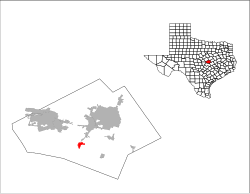Buttermilk Creek Complex
| Buttermilk Creek Complex | |
|---|---|
 Location of Salado, Texas |
|
 |
|
| Coordinates: 30°53′32″N 97°42′35″W / 30.89222°N 97.70972°WCoordinates: 30°53′32″N 97°42′35″W / 30.89222°N 97.70972°W | |
| Country | United States |
| State | Texas |
| County | Bell |
| Elevation | 600 ft (183 m) |
| Time zone | Central (CST) (UTC-6) |
| • Summer (DST) | CDT (UTC-5) |
| ZIP code | 76571 |
Buttermilk Creek Complex refers to the remains of a paleolithic settlement along the shores of Buttermilk Creek in present day Salado, Texas dated to approximately 15,500 years old. If confirmed, the site represents evidence of human settlement in the Americas that pre-dates Clovis culture.
The Buttermilk Creek Complex found at the Debra L. Friedkin Paleo-Indian archaeological site in Bell County, Texas has provided archaeological evidence of a human presence in the Americas that pre-dates the Clovis peoples, who until recently were thought to be the first humans to colonize the New World. The site’s pre-Clovis occupation is supported by numerous lines of evidence including optically stimulated luminescence (OSL) dates ranging from 13,200-15,500 before present, undisturbed stratigraphy, and an extensive stone tool assemblage. OSL is a technique that analyzes light energy trapped in sediment particles to identify the last time the soil was exposed to sunlight.
Dr. Michael R. Waters from Texas A&M University along with a group of graduate and undergraduate students began excavating the Debra L. Friedkin Site in Bell County, Texas in 2006. The site is located 250m downstream along Buttermilk Creek from the Gault Site; a Paleo-Indian site excavated in 1998 and found to have deeply stratified deposits including a Clovis horizon.
Early humans would have been attracted to the area surrounding Buttermilk Creek due its favorable climate, abundance of food resources, a year-round water source, but most importantly because the area was a source of very high quality Edward’s Chert stone. They would have made tools out of chert nodules using a technique called flint knapping which employs the striking of hammer stones and antler billets to remove flakes of chert until the nodules are reduced to bifacial shape.
...
Wikipedia
